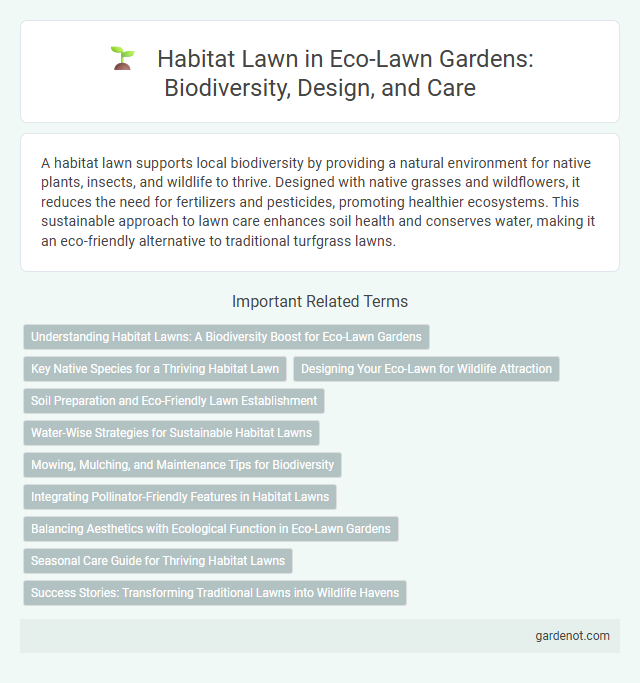A habitat lawn supports local biodiversity by providing a natural environment for native plants, insects, and wildlife to thrive. Designed with native grasses and wildflowers, it reduces the need for fertilizers and pesticides, promoting healthier ecosystems. This sustainable approach to lawn care enhances soil health and conserves water, making it an eco-friendly alternative to traditional turfgrass lawns.
Understanding Habitat Lawns: A Biodiversity Boost for Eco-Lawn Gardens
Habitat lawns enhance biodiversity by incorporating native grasses and wildflowers, creating a thriving ecosystem for pollinators and wildlife within eco-lawn gardens. These lawns require less water and maintenance compared to traditional turf, promoting sustainability and reducing environmental impact. Integrating habitat lawns supports soil health, encourages natural pest control, and fosters a balanced urban habitat.
Key Native Species for a Thriving Habitat Lawn
Key native species essential for a thriving habitat lawn include native grasses like Little Bluestem (Schizachyrium scoparium) and Buffalograss (Bouteloua dactyloides), which provide structural support and soil stability. Wildflowers such as Purple Coneflower (Echinacea purpurea) and Black-eyed Susan (Rudbeckia hirta) attract pollinators including bees and butterflies, enhancing biodiversity. Incorporating native sedges like Carex spp. helps improve water retention and offers habitat for ground-nesting insects, ensuring a resilient and balanced ecosystem.
Designing Your Eco-Lawn for Wildlife Attraction
Designing your Habitat lawn involves selecting native grass species and wildflowers that provide food and shelter for local pollinators, birds, and beneficial insects. Incorporating layers of vegetation, such as low-growing ground covers and taller grasses, creates diverse habitats that support biodiversity. Strategic placement of mulch and water sources further enhances the lawn's appeal to wildlife, promoting a balanced and thriving ecosystem.
Soil Preparation and Eco-Friendly Lawn Establishment
Habitat lawn soil preparation involves minimal disturbance to preserve existing microbial life, promoting natural aeration and moisture retention essential for eco-friendly lawn establishment. Incorporating organic compost and avoiding synthetic fertilizers enhances soil fertility and supports native plant growth, reducing the need for chemical inputs. This approach fosters biodiversity, improves soil structure, and creates a resilient, sustainable lawn ecosystem.
Water-Wise Strategies for Sustainable Habitat Lawns
Habitat lawns utilize drought-tolerant grass species and deep-rooted native plants to reduce water consumption by up to 50% compared to traditional lawns. Incorporating efficient irrigation methods like drip systems and rainwater harvesting further enhances water conservation in sustainable habitat lawns. Soil health improvement through organic mulching and aeration promotes moisture retention, ensuring resilient and eco-friendly landscapes.
Mowing, Mulching, and Maintenance Tips for Biodiversity
Habitat lawns thrive with careful mowing practices that support biodiversity, such as mowing less frequently and setting mower blades higher to protect native plants and beneficial insects. Mulching with organic materials enriches soil health, retains moisture, and provides habitats for microorganisms crucial to ecosystem balance. Regular maintenance includes removing invasive species, watering appropriately, and avoiding chemical pesticides to promote a diverse, resilient lawn ecosystem.
Integrating Pollinator-Friendly Features in Habitat Lawns
Habitat lawns incorporate native flowering plants and grasses that attract and support pollinators like bees, butterflies, and hummingbirds, enhancing biodiversity and ecosystem health. Planting a diverse mix of nectar-rich species with staggered bloom times ensures continuous food sources for pollinators throughout the growing season. Incorporating habitat features such as bare ground patches and native shrubs further provides nesting and shelter opportunities, promoting sustainable pollinator populations in residential and urban green spaces.
Balancing Aesthetics with Ecological Function in Eco-Lawn Gardens
Habitat lawns integrate native grasses and wildflowers to create visually appealing landscapes that support local biodiversity and promote soil health. These eco-lawn gardens provide essential habitats for pollinators, birds, and beneficial insects while maintaining a tidy and resilient green space. Balancing aesthetics with ecological function involves selecting low-maintenance plant species that thrive in regional climates, reducing water use and minimizing chemical inputs.
Seasonal Care Guide for Thriving Habitat Lawns
Habitat lawns require tailored seasonal care to promote biodiversity and maintain healthy growth throughout the year. Spring involves overseeding native grasses and wildflowers to enhance habitat value, while summer care focuses on moderate watering and selective mowing to support pollinators and reduce water usage. Fall season priorities include soil aeration and applying organic mulch to prepare the lawn for winter dormancy and sustain soil health.
Success Stories: Transforming Traditional Lawns into Wildlife Havens
Habitat lawns have successfully transformed traditional turf into vibrant wildlife havens by integrating native plants and reducing chemical use, which supports pollinators and local biodiversity. Homeowners report increased sightings of bees, butterflies, and native birds, showcasing the ecological benefits of these sustainable landscapes. These success stories highlight the potential for eco-lawns to restore natural habitats while maintaining functional, beautiful outdoor spaces.
Habitat lawn Infographic

 gardenot.com
gardenot.com